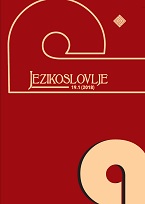Mjesni govor Blaževaca u svjetlu pripadnosti zapadnome poddijalektu kajkavskoga goranskoga dijalekta
The local speech of Blaževci in the light of its classification into the western subdialect of the Kajkavian Gorski kotar dialect
Author(s): Marina MarinkovićSubject(s): Language studies, Language and Literature Studies, Phonetics / Phonology, Morphology, Sociolinguistics, South Slavic Languages, Philology
Published by: Filozofski fakultet, Sveučilište Josipa Jurja Strossmayera, Osijek
Keywords: Kajkavian Gorski kotar dialect; western subdialect; Blaževci; phonology; morphology; progressive shift of the Slavic old circumflex;
Summary/Abstract: The local speech of Blaževci is geographically located at the boundary of two subdialects of the Kajkavian Gorski kotar dialect. Although Croatian dialectologists previously classified it as belonging to the western subdialect, this local speech has not been a subject of targeted research. Using the principles of structural dialectology, field research on the local speech of Blaževci has recently been conducted on the phonological and, to a lesser extent, morphological level. Based on the collected data, the work analyzes vocalism, consonantism and prosody (inventory, distribution, and origin of units) and noun declension. The aim of this paper is to determine the affiliation of the local speech of Blaževci to a higher hierarchical level, while respecting the principles and criteria of dialectological classification. Therefore, in the analysis of the material the emphasis is put on vocalism and prosody. The most prominent prosodic feature linking this speech to western speeches of Gorski kotar is the progressive shift of the Slavic old circumflex, the isogloss that is largely absent in the eastern subdialect. Other phonological and morphological features shared with western Kajkavian speeches of Gorski kotar were recorded: subsequent lengthening of initially short vowels, multiple vowel alternations (o → a, u → i), noun declension reflecting the initial palatal variants of the major changes in nouns of masculine, feminine, or neuter genders. However, some of the features that associate this speech with eastern Kajkavian speeches of Gorski kotar were confirmed, such as monophthong vocalism, the absence of - m > -n change in the final position, the fluctuation in the reflex of old acute beyond the last syllable etc. All the above points refer to the marginal position of the local speech of Blaževci and to the conclusion that this local speech comprises characteristics of both eastern and western subdialects of Kajkavian dialect of Gorski kotar. However, given that the accentual features, as the most important classification criterion, are closer to western speeches, based on the analysis that was carried out, this local speech is placed in the western subdialect of Kajkavian Gorski kotar dialect.
Journal: Jezikoslovlje
- Issue Year: XIX/2018
- Issue No: 1
- Page Range: 39-63
- Page Count: 25
- Language: Croatian

